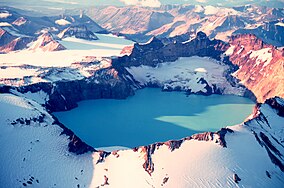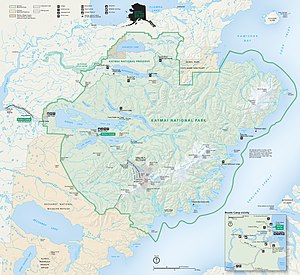
Back منتزه ومحمية كاتماي الوطنية Arabic Taman Nasional miwah Cagar Palemahan Katmai BAN Parc i Reserva Nacional de Katmai Catalan Katmai National Park CEB Národní park Katmai Czech Katmai National Park Danish Katmai-Nationalpark German Parque nacional y reserva Katmai Spanish Katmai rahvuspark Estonian Katmai Parke Nazionala eta Babesgunea Basque
| Katmai National Park and Preserve | |
|---|---|
 The summit crater lake of Mount Katmai | |
| Location | Lake and Peninsula, Kodiak Island, Kenai Peninsula, and Bristol Bay boroughs, Alaska, United States |
| Nearest city | King Salmon |
| Coordinates | 58°30′N 155°00′W / 58.5°N 155°W |
| Area | 4,093,077 acres (16,564.09 km2)[2] |
| Established | December 2, 1980 |
| Visitors | 37,818 (in 2015 – latest count)[3] |
| Governing body | National Park Service |
| Website | Katmai National Park & Preserve |
 Map of Katmai National Park and Preserve Map of Katmai National Park and surrounding area | |
Katmai National Park and Preserve is an American national park and preserve in southwest Alaska, notable for the Valley of Ten Thousand Smokes and for its brown bears. The park and preserve encompass 4,093,077 acres (6,395.43 sq mi; 16,564.09 km2), which is between the sizes of Connecticut and New Jersey. Most of the national park is a designated wilderness area. The park is named after Mount Katmai, its centerpiece stratovolcano. The park is located on the Alaska Peninsula, across from Kodiak Island, with headquarters in nearby King Salmon, about 290 miles (470 km) southwest of Anchorage. The area was first designated a national monument in 1918 to protect the area around the major 1912 volcanic eruption of Novarupta, which formed the Valley of Ten Thousand Smokes, a 40-square-mile (100 km2), 100-to-700-foot-deep (30 to 213 m) pyroclastic flow. The park includes as many as 18 individual volcanoes, seven of which have been active since 1900.
Initially designated because of its volcanic history, the monument was left undeveloped and largely unvisited until the 1950s. The monument and surrounding lands became appreciated for their wide variety of wildlife, including an abundance of sockeye salmon and the brown bears that feed upon them. After a series of boundary expansions, the present national park and preserve were established in 1980 under the Alaska National Interest Lands Conservation Act.
- ^ "Protected Area Profile for Katmai from the World Database of Protected Areas". protectedplanet.net. UN World Conservation Monitoring Centre and the IUCN. Retrieved September 7, 2021.
- ^ "Listing of acreage – December 31, 2011" (XLSX). Land Resource Division, National Park Service. Retrieved March 7, 2012. (National Park Service Acreage Reports)
- ^ "NPS Annual Recreation Visits Report". National Park Service. Retrieved March 7, 2019.



